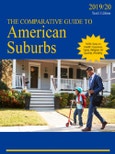The Comparative Guide to American Suburbs provides detailed statistical information on 3,159 suburban communities (28 more than the last edition) with populations of 10,000 or more, surrounding the 80 largest metropolitan areas in the United States. This guide has been designed for individuals who are in need of easy to use statistics for relocation or small business owners looking to expand. The combination of usability, the currency of data, breadth of scope, and ranking tables make this an exceptional guide to aid in relocation.
The Comparative Guide to American Suburbs is arranged alphabetically, first by metro area - from Akron, OH to Worcester, MA - then by individual suburb within each metro area. This two-volume statistical reference source begins with a helpful Introduction and User Guide to give readers a comprehensive explanation of the layout and source used in this edition. Next, come the metro area chapters, each of which begins with a State Map that outlines the suburbs, boundaries, and counties, as well as a Metropolitan Map that shows the location of each suburb in relation to its metropolitan center. Following this is a Metro Area Profile that includes major areas of concentration: Geography, Climate, Demographics, Religion, Income, Education, Housing, Health Insurance Coverage, and Air Quality. 29 subcategories are also included.
Within these Metro Area, Profiles are individual Suburb Profiles for the metropolitan area covered. Each Suburb Profile includes 12 areas of concentration: Geography, History, Demographics, Economic Indicators, Employment by Occupation, Income, Taxes, Educational Attainment, Housing, Health Insurance Coverage, Transportation, and Safety. These areas are broken down into 45 subcategories.
Following the Suburb Profiles in each chapter are Ranking Charts that rank all suburbs in each metropolitan area according to 71 data points - from first to last. These rankings include topics such as Poverty Rate, Population Density, Ancestry, Travel Time to Work, Homeowner Costs with/without Mortgage, Median Home Value, Violent Crime Rate, Unemployment Rate, and Educational Attainment.
National Rankings comprise more than 600 pages at the end of this edition, ranking al 3,159 suburbs according to the 71 Ranking Chart data points, allowing for easy comparison of all suburbs in the nation at once. These ranking sections are particularly useful for those looking to compare suburbs in the same metro area, or looking to compare suburban areas in different parts of the state or country.
The Comparative Guide to American Suburbs also features two helpful indexes. The Metropolitan Area Index is an alphabetical list of all 80 metro areas, along with their states, counties, and suburbs, indicating on what page their profiles appear. The second is the Suburb Index which is an alphabetical list of all 3,159 suburbs.
The Comparative Guide to American Suburbs, 2019-2020 pulls together all available, current statistics, demographic and contact information to create consolidated, comprehensive profiles of suburban communities, as well as comparative statistics and rankings available nowhere else. This edition is a must-have addition to any reference collection.
Profiles of New Jersey, Sixth Edition (2022)
- Book
- 700 Pages
- United States








